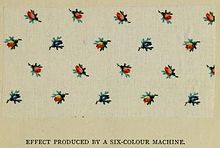Walter Crum
Walter Crum (* 1796 in Glasgow ; † May 5, 1867 in Rouken ) was a Scottish chemist and entrepreneur .

Crum was the son of an owner of a calico printer , which he took over after studying chemistry in Glasgow at Anderson's University (with Thomas Graham ) and two years with the chemist and calico printer James Thomson (1779-1850). The company was based in Thornliebank near Glasgow.
He dealt with dyeing and textile printing and published 14 papers on it. His achievements in chemistry include:
- Purification of indigo by sublimation, representation of indigosulfonic acids (1823)
- Dyeing theory of textile fibers with absorption of color as a result of capillarity (1843)
- a blood liquor salt indicator for the bleaching agent hypochlorite (1840)
- Lead dioxide test for manganese (1845). In the same year he also succeeded in producing copper oxide with trivalent copper using bleach.
- Detection of nitrates with sulfuric acid and mercury (1847) and, in this context, representation of pure nitrogen oxide
- Representation of colloidal aluminum (1854) from boiling aluminum acetate solution.
Crum later bought Rouken Glen Park at Giffnock , which was donated by a descendant of the City of Glasgow. In 1844 he became a Fellow of the Royal Society . His son Alexander Crum was a member of parliament and father of the coptologist Walter Ewing Crum . His daughter Margaret was married to the physicist Lord Kelvin .
literature
- Winfried Pötsch u. a. Lexicon of important chemists , Harri Deutsch 1989
References and comments
- ↑ Thomson was accepted into the Royal Society , not least at the suggestion of his students Crum and Lyon Playfair and Graham
| personal data | |
|---|---|
| SURNAME | Crum, Walter |
| BRIEF DESCRIPTION | Scottish chemist and entrepreneur |
| DATE OF BIRTH | 1796 |
| PLACE OF BIRTH | Glasgow |
| DATE OF DEATH | May 5, 1867 |
| Place of death | Rouken |
